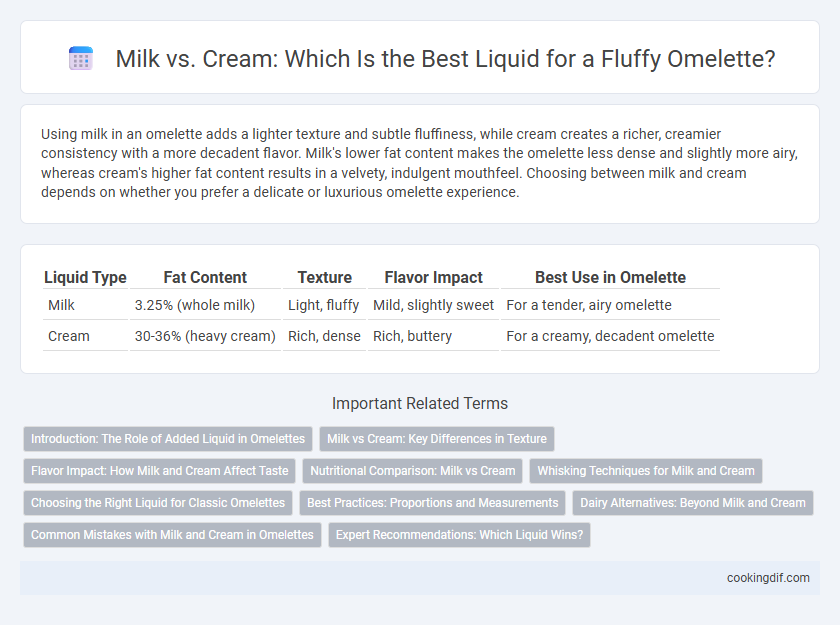Using milk in an omelette adds a lighter texture and subtle fluffiness, while cream creates a richer, creamier consistency with a more decadent flavor. Milk's lower fat content makes the omelette less dense and slightly more airy, whereas cream's higher fat content results in a velvety, indulgent mouthfeel. Choosing between milk and cream depends on whether you prefer a delicate or luxurious omelette experience.
Table of Comparison
| Liquid Type | Fat Content | Texture | Flavor Impact | Best Use in Omelette |
|---|---|---|---|---|
| Milk | 3.25% (whole milk) | Light, fluffy | Mild, slightly sweet | For a tender, airy omelette |
| Cream | 30-36% (heavy cream) | Rich, dense | Rich, buttery | For a creamy, decadent omelette |
Introduction: The Role of Added Liquid in Omelettes
Milk and cream influence the texture and richness of an omelette by adding moisture and fat. Cream increases the omelette's creaminess and tenderness due to its higher fat content, resulting in a fluffier and more luxurious bite. Milk provides a lighter, less rich texture that maintains a delicate structure without overwhelming the eggs' natural flavor.
Milk vs Cream: Key Differences in Texture
Milk creates a lighter, fluffier omelette texture due to its lower fat content and higher water ratio, allowing steam to puff the eggs. Cream, with its rich fat concentration, produces a denser, silkier omelette that feels creamier and more indulgent on the palate. Choosing milk results in a tender, airy consistency, while cream yields a smooth, custard-like finish.
Flavor Impact: How Milk and Cream Affect Taste
Milk adds a subtle creaminess to omelettes, enhancing their flavor without overwhelming the natural egg taste. Cream infuses a richer, more decadent texture, creating a buttery, luxurious mouthfeel that intensifies the overall flavor profile. Choosing cream elevates the indulgence factor, while milk maintains a lighter, more balanced taste.
Nutritional Comparison: Milk vs Cream
Milk contains significantly fewer calories and fat than cream, making it a lighter option for added liquid in omelettes. Whole milk provides about 9 grams of fat and 150 calories per cup, while heavy cream contains approximately 88 grams of fat and 820 calories per cup. Milk also offers essential nutrients like calcium and vitamin D without the high saturated fat content found in cream.
Whisking Techniques for Milk and Cream
Whisking milk into an omelette mixture creates a lighter, airier texture by incorporating small air bubbles, resulting in a tender and fluffy finish. Using cream requires gentler whisking to avoid over-aeration, preserving its richness and yielding a creamier, denser omelette. Mastering the distinct whisking techniques for milk and cream maximizes texture and flavor in the final dish.
Choosing the Right Liquid for Classic Omelettes
Choosing milk or cream as the added liquid for classic omelettes depends on desired texture and richness; milk offers a lighter, fluffier result with fewer calories, while cream delivers a richer, creamier texture and more indulgent flavor. Whole milk is preferred for a balanced creaminess and ease of incorporation, whereas heavy cream thickens the eggs and enhances moisture retention without thinning the batter. Ice-cold milk or cream can improve the omelette's tenderness by slowing protein coagulation during cooking.
Best Practices: Proportions and Measurements
Using milk or cream in omelettes affects texture and richness, with milk adding lightness and cream providing a denser, creamier result. Best practices suggest adding 1 to 2 tablespoons of milk or cream per two eggs to achieve optimal moisture without compromising structure. Maintaining these proportions ensures a fluffy yet tender omelette, balancing liquid content for perfect cooking consistency.
Dairy Alternatives: Beyond Milk and Cream
Choosing dairy alternatives for omelette liquid can enhance flavor and texture while catering to dietary restrictions. Options like almond milk, coconut milk, or oat milk provide unique profiles, with almond adding a subtle nutty taste and coconut imparting richness without the heaviness of cream. These plant-based liquids contribute moisture and binding properties, creating fluffy omelettes suitable for vegan or lactose-intolerant individuals.
Common Mistakes with Milk and Cream in Omelettes
Using milk in omelettes often leads to a watery texture because it adds too much liquid without enough fat, while cream provides richness and a fluffier consistency due to its higher fat content. Common mistakes include over-pouring milk, which dilutes the eggs, and using heavy cream excessively, resulting in a dense or greasy omelette. Balancing the ratio of eggs to liquid--typically one tablespoon of milk or cream per two eggs--ensures optimal texture and flavor.
Expert Recommendations: Which Liquid Wins?
Experts consistently recommend using cream over milk when adding liquid to omelette mixtures for a richer, creamier texture and enhanced flavor. Cream's higher fat content contributes to a tender, fluffy omelette compared to milk, which can result in a slightly drier, less flavorful dish. Culinary authorities emphasize that small amounts of heavy cream, about one tablespoon per three eggs, optimize moisture and mouthfeel without overwhelming the egg's natural taste.
Milk vs cream for added liquid Infographic

 cookingdif.com
cookingdif.com